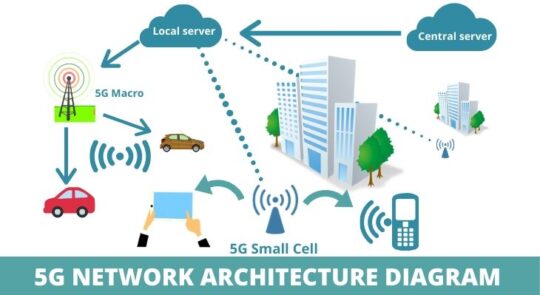The previous generation of networks was into the ability to provide end-users with better data services only.
However, with the coming of 5G networks, the definition has completely changed, from supporting multiple applications in the consumer segment along with providing support to business verticals as well.
The whole of the 5G system includes a user terminal which is supported by autonomous radio access technologies consisting of cells, towers, systems that connect the mobile users, and wireless devices to core networks.
Core networks, on the other hand, are responsible for the handling of mobile connections as well as internet connections.
Still, in its early days, the 5G network could be well explained with 4G technology as it is currently in conjugation with it. The current network of 5G consists of two main components:
- Radio Access Network
- Core Network
To use a 4G network, a frequency of 2-6 GHz is needed, but that’s only good for the traditional set of technologies. With the world adopting much better technologies, like 5G, the same frequency won’t do any good.
So, in order to counter this issue, the usage of millimeter waves are brought into action.
Millimeter waves have a better frequency spectrum of 30-300 GHz, with the transmission through millimeter waves being fast.
But the drawback of these waves is that they aren’t able to penetrate through trees, buildings, and mountains. Thus smaller cells are introduced.
Instead of opting for one powerful antenna, these smaller cells are brought in to work together to counter the attenuation issues.
In the radio access network, apart from millimeter waves and small cells, 5G closely depends on MIMO antennas as well.
Earlier in 4G networks, there was the usage of approximately dozens of such antennas, but considering the concept of a faster network i.e. 5G, such antennas are increased multiple times. Thereby, allowing the faster transmissions to happen.
MIMO antennas while making the faster transmission a reality, do encounter a glitch which is interference.
Transference of many signals from the same stations leads to interference issues that are easily encountered by beamforming.
Beamforming allows the transmission of higher beam signals through a single port, first in a particular direction thus reducing the issue of interference.
The core network, on the other hand, manages the data as well as the internet connection. As of now, the core network is being redesigned to work better with other platforms like a cloud.
The Core network also provides the facility of functions like network slicing and distributed servers that are responsible for better response.
Three sets of use cases were suggested for the implications of the 5G network after considering more than 70 cases. It consists of three sets
- eMBB (Enhanced Mobile Broadband)
- URLLC (Ultra-Reliable Low Latency Communication)
- mMTC (massive Machine Type Communications)
The main concept behind these use cases was to categorize the usage patterns and features that the 5G network will need to deliver.
Often it happens that signal strength is weak in certain areas. To bridge the gap cellular repeaters are used.
5G allows the concept of multiple hop networks and devices to device communication which improves the signal strength and connectivity.
Multiple hop networks work on the concept of relaying data to other nodes to deliver quality service.
Whereas device to device communication works on the concept of allowing two users to communicate without any dependency on base stations.
Future technologies like 5G are more inclined towards this process wherein processing of information is done remotely.
A radio access network provides a connecting link between base stations and end-users.
Whereas in the CRAN, signals get processed remotely and the base unit is connected with efficient fiber-optic connection, thus maintaining the efficient services.
All of this is supported by the concept of cloud computing and is built on interface cards which are efficient in handling interconnections within the stations.
Carrier aggregation can simply be explained as the medium of carrying data. In carrier aggregation, more than two data carriers are combined in a single channel for optimizing data capacity.
Mainly three techniques are used in it
- intra-band contiguous
- intra-band non-contiguous
- Inter-band

Conclusion
With an estimated launch in the year 2020, 5G is expected to be one of the biggest technology wonders.
From high-speed downloads to uploads, from in house medical surgeries to remote surgeries and from self-driving cars to drones, 5G seems to be taking an edge over everything.
5G is going to ensure billions of new connections with speed and security.
The concept of 5G seems to be very revolutionary which will not only help the people in terms of speed but also will be the reason for the fourth industrial revolution which will, in short, pave the way for maximum automation resulting in lesser errors and better decisions.
You may also like to read:




